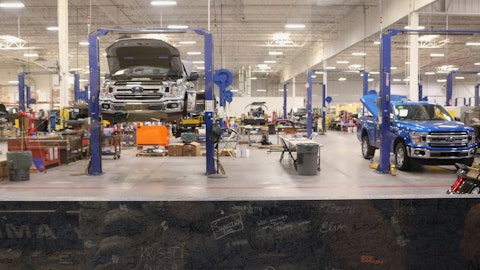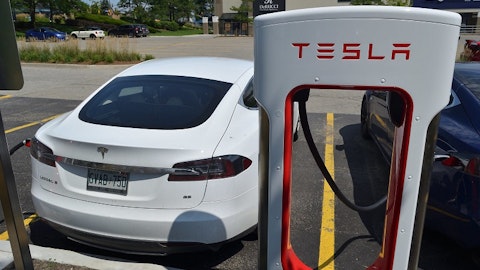Chris McNally: That’s great. And just as the last thing, because I know it’ll come up. Joe, I think the 2025 was 14% to 14.5% margin, 100 bps to 150 bps off that. Can we just kind of take that as the new ’25 as roughly 13% and then, like you said, push the year out to ’26? I just know that will come up the rest of the call.
Joe Massaro: Yeah, I think round numbers, that’s pretty good, Chris. If you wanted, I’d probably be closer somewhere between 12.5% and 13%.
Chris McNally: Perfect. Thanks so much.
Operator: And our next question is going to come from Rod Lache from Wolfe Research.
Rod Lache: Good morning, everybody. Just, first of all, to clarify some of the discussion off of Chris’ question. Obviously, we’ve seen some ongoing share shift away from the western OEMs over the past couple of years, and it sounds like the reason why you don’t expect that to reoccur in 2024 is because of the big uptick in backlog that you have from BYD, Changan and some of the other Chinese OEMs. Is that essentially it?
Joe Massaro: I think there’s a couple — I’m not sure I understand that, Rod. I think there’s a couple of things. I think overall you had some 30%-plus growth quarters by those local Chinese OEMs, right? We do think that. And again, from what we’re seeing in a scheduled perspective, and when we look at that, there’s a couple of forecasting services that sort of look at that market, that starts to level off a bit, right? They catch up to some of their high comps. At the same time, launch activity with the multinationals who admittedly have had, I think, some platform challenges over the last couple of years in China, do have new launches coming up, and those launches were on those platforms, and we expect to see that sort of take their overall production up, our content up, which is how we’re sort of looking at it, starting to balance out. And then you obviously have the mixed shift inherited within our business that Kevin took you through.
Rod Lache: Okay.
Kevin Clark: So, Rod, at a high level, we expect share to continue to shift to the local OEMs. I think what Joe and I were talking about is the magnitude of the shift over a relatively short period of time. We expect that not to be the same in 2024 as it was in 2023.
Rod Lache: Right. Okay. Understood. On high voltage, it looks like you’re implicitly assuming a similar level of EV growth in 2024 versus what you saw in 2023. As you’ve observed, there’s been some slowing late in the year in 2023. Maybe you can elaborate on the models or factors that you consider that lead you to conclude that the growth is pretty similar for EVs. And can you maybe also give us any color on the assumptions that you make behind those high voltage bookings? Do you have a penetration assumption? Or is there some color you can provide that helps you underwrite that level of revenue associated with the bookings?
Joe Massaro: Yeah. So, obviously, much like the rest — the other parts of our business, we’re looking at customer schedules, which include customer launches. And you’re right, we’re right around that 20% growth rate for ’24, which was consistent with ’23. There are some new program launches. Again, that business is 80% China, Europe, right? So, clearly seeing some weakening in North America. We’ve seen schedules come down. I think that’s well understood at this point. But the combination of sort of some new product launches and where we see customer schedules and then really that sort of the concentration we have in that business around China and Europe. I think penetration rates, we’ve always been lower on a relative basis at this point, where we have not looked out to sort of 2030, to update what we talked about in February, possibly that’s lower than 30%.
I think we were sort of well behind everyone else. But I think over the next few years, you’re moving in within that sort of, call it, that 10% to 15% range, is what our numbers would extrapolate out to.
Rod Lache: Okay. All right, thank you.
Operator: And our next question is going to come from Itay Michaeli. Please go ahead.
Itay Michaeli: Great. Thank you. Good morning, everyone. Just a first question on the long-term growth over market. I know that the Investor Day last year, there was an expectation of some acceleration beyond 2025. Obviously, a lot changing here in the near term, but the bookings are still strong and growing. So just a question, do you still think there’s scope for some GOM acceleration in the second half of the decade?
Kevin Clark: Itay, it’s Kevin. Listen, as it relates to, is there an opportunity for accelerated growth, if you look at the last three years, we’ve booked roughly the same amount of business as we booked the prior five years to the start of that three-year period. So, the growth opportunity — revenue growth opportunity is significant. There are certain items, as we look at growth over market, and we use that as a proxy for strength of our competitive position. We’re not on every OEM across the globe. And when you look at that calculation, although certainly indicative of strength of growth, it’s not perfect. So, would we tell you, should there be a bias based on bookings of stronger growth, accelerating growth? Absolutely. In light of kind of the current environment and discussion about EV penetration rates as an example, can things shift a bit quarter to quarter or maybe a year to a year?
It’s possible. But as we look at where the environment is today, as we look at where investor expectations are, we think the 6% to 8% growth over market is the right sort of framework for folks to consider, for investors to consider.
Itay Michaeli: That’s very helpful. Thanks, Kevin. And just a quick follow up on the ADAS business. I was hoping you could share what you’re expecting ADAS growth this year, and also maybe a bit more color on the wins with the Japanese OEMs, whether that provides further opportunities to penetrate with those OEMs.
Joe Massaro: Yeah. Let me start with the growth rates, and then Kevin can comment on the nature of the win. So, continue to see strong growth in active safety. Would expect 2024 to be north of 20% again, as it was this year. I do think — listen, one of the things we talked about, just to put it in perspective, there is a large active safety business in North America with a couple of the D3, that was obviously impacted this year by the strike, right? So, it’s not immune to things like the strike, but the underlying fundamentals of that business, the take rates and the growth will keep it above 20% again next year.




